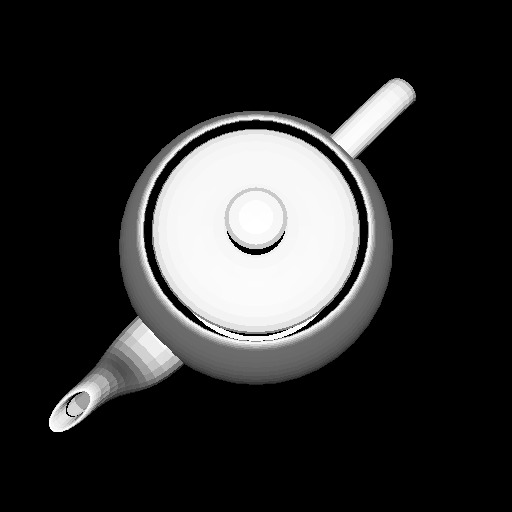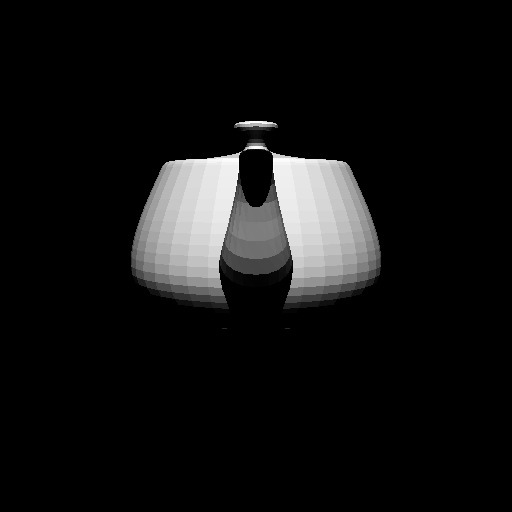Introduction to rendering using RayTracer.jl
In this example we will render the famous UTAH Teapot model. We will go through the entire rendering API. We will load an obj file for the scene. This needs to be downloaded manually.
Run this code in your terminal to get the file: wget https://raw.githubusercontent.com/McNopper/OpenGL/master/Binaries/teapot.obj
If you are using REPL mode you need the ImageView.jl package
using RayTracer, Images #, ImageViewGeneral Attributes of the Scene
Specify the dimensions of the image we want to generate. screen_size is never passed into the RayTracer directly so it need not be a named tuple.
screen_size = (w = 256, h = 256)Load the teapot object from an obj file. We can also specify the scene using primitive objects directly but that becomes a bit involved when there are complicated objects in the scene.
scene = load_obj("teapot.obj")We shall define a convenience function for rendering and saving the images. For understanding the parameters passed to the individual functions look into the documentations of get_primary_rays, raytrace and get_image
function generate_render_and_save(cam, light, filename)
#src # Get the primary rays for the camera
origin, direction = get_primary_rays(cam)
#src # Render the scene
color = raytrace(origin, direction, scene, light, origin, 2)
#src # This will reshape `color` into the proper dimensions and return
#src # an RGB image
img = get_image(color, screen_size...)
#src # Display the image
#src # For REPL mode change this to `imshow(img)`
display(img)
#src # Save the generated image
save(filename, img)
endUnderstanding the Light and Camera API
DistantLight
In this example we will be using the DistantLight. This king of lighting is useful when we want to render a scene in which all parts of the scene receive the same intensity of light.
For the DistantLight we need to provide three attributes:
- Color - Color of the Light Rays. Must be a Vec3 Object
- Intensity - Intensity of the Light
- Direction - The direction of light rays. Again this needs to be a Vec3 Object
Camera
We use a perspective view Camera Model in RayTracer. Let us look into the arguments we need to pass into the Camera constructor.
- LookFrom - The position of the Camera
- LookAt - The point in 3D space where the Camera is pointing
- vup - The UP vector of the world (typically Vec3(0.0, 1.0, 0.0), i.e. the y-axis)
- vfov - Field of View of the Camera
- Focus - The focal length of the Camera
- Width - Width of the output image
- Height - Height of the output image
Rendering Different Views of the Teapot
Now that we know what each argument means let us render the teapot
TOP VIEW Render
light = DistantLight(
Vec3(1.0f0),
100.0f0,
Vec3(0.0f0, 1.0f0, 0.0f0)
)
cam = Camera(
Vec3(1.0f0, 10.0f0, -1.0f0),
Vec3(0.0f0),
Vec3(0.0f0, 1.0f0, 0.0f0),
45.0f0,
1.0f0,
screen_size...
)
generate_render_and_save(cam, light, "teapot_top.jpg")

SIDE VIEW Render
light = DistantLight(
Vec3(1.0f0),
100.0f0,
Vec3(1.0f0, 1.0f0, -1.0f0)
)
cam = Camera(
Vec3(1.0f0, 2.0f0, -10.0f0),
Vec3(0.0f0, 1.0f0, 0.0f0),
Vec3(0.0f0, 1.0f0, 0.0f0),
45.0f0,
1.0f0,
screen_size...
)
generate_render_and_save(cam, light, "teapot_side.jpg")

FRONT VIEW Render
light = DistantLight(
Vec3(1.0f0),
100.0f0,
Vec3(1.0f0, 1.0f0, 0.0f0)
)
cam = Camera(
Vec3(10.0f0, 2.0f0, 0.0f0),
Vec3(0.0f0, 1.0f0, 0.0f0),
Vec3(0.0f0, 1.0f0, 0.0f0),
45.0f0,
1.0f0,
screen_size...
)
generate_render_and_save(cam, light, "teapot_front.jpg")

Next Steps
- Try Rendering complex environments with RayTracer
- Look into the other examples in
examples/ - Read about inverse rendering and see the examples on that
This page was generated using Literate.jl.